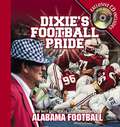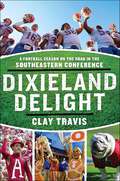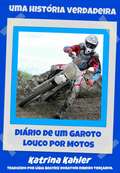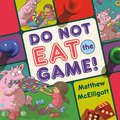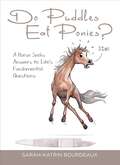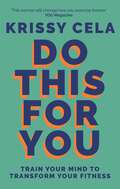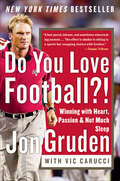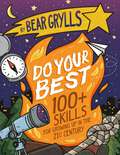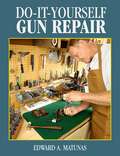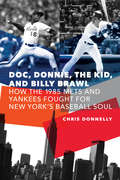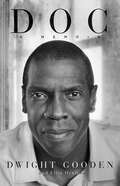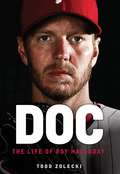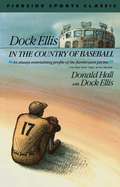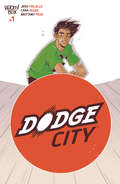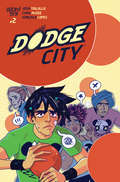- Table View
- List View
Dixie's Football Pride
by Athlon SportsTrue Crimson Tide fans can tell you where they were when championships were won, heartbreakers were lost, records were broken, and heroes were made. Dixie's Football Pride is a gift book for true University of Alabama fans, celebrating the history, the pageantry, and the drama of Alabama Football in both print and on an audio CD that Crimson Tide fans will listen to over and over.Dixie's Football Pride is a tribute to a football program that has received national acclaim and a loyalty within its region that few schools achieve.The audio CD contains the school's fight song and classic calls of the most memorable plays in University of Alabama football history.
Dixieland Delight: A Football Season on the Road in the Southeastern Conference
by Clay TravisThere is no college ball more passionate and competitive than football in the Southeastern Conference, where seven of the twelve schools boast stadiums bigger than any in the NFL and 6.5 million fans hit the road every year to hoot and holler their teams to victory.In September 2006, popular sports columnist and lifelong University of Tennessee fan Clay Travis set out on his "Dixieland Delight Tour." Without a single map, hotel reservation, or game ticket, he began an 8,000-mile journey through the beating heart of the Southland. As Travis toured the SEC, he immersed himself in the bizarre game-day rituals of the common fan, brazenly dancing with the chancellor's wife at a Vanderbilt frat party, hanging with University of Florida demigod quarterback Tim Tebow, and abandoning himself totally to the ribald intensity and religious fervor of SEC football. Dixieland Delight is Travis's hilarious, loving, irreverent, and endlessly entertaining chronicle of a season of ironic excess in a world that goes a little crazy on football Saturdays.
Diário de um Garoto Louco por Motos
by Katrina Kahler Lígia Beatriz Donatoni Ribeiro TerçariolNate é definitivamente um garoto apaixonado por motocross. Acompanhe suas aventuras enquanto ele descobre quão intenso e emocionante o motociclismo pode ser. Desde muito jovem, com a chegada de sua primeira moto 90cc, Nate é fisgado pra sempre. Depois ele descobre o motocross, e as rampas e mesas dão uma adrenalina que ele nunca tinha sentido antes. Rampas maiores levam a motos maiores, e é aí que ele descobre que Hondas e Yamahas são as motos de seus sonhos. Mas isso só pode levar a quedas, acidentes e até ambulâncias, enquanto o garoto louco por motos descobre os perigos pelos quais esse esporte é tão famoso! Conheça as aventuras de Nate enquanto ele aprende a enfrentar seus medos e encara todos os desafios que somente o motocross pode proporcionar.
Do It Yourself Bonefishing
by Rod HamiltonDo It Yourself Bonefishing is the authoritative guide written for DIY anglers targeting bonefish on the fly. Divided into easy-to-reference sections, this book will help you tackle the why, where, and how of self-guided bonefishing. Informed by twenty years of experience on the flats, Rod Hamilton and Kirk Deeter describe the allure of matching wits with one of fly fishing&’s most elusive targets and discuss the reasons why more and more fly fishermen are seeking the challenge of catching bonefish without the aid of a guide. Do It Yourself Bonefishing is packed with useful tips to help all levels of fly fishermen locate and catch more of one of the world&’s premier gamefish. Learn stalking strategies, how to spot bonefish, appropriate fly selection, and where to find the fish.As you plan your bonefishing trip, the authors&’ destination chapters and &“Seven-Day Sample Trip&” itineraries suggest where to fish, how to get there, and places to stay. Included is a list of more than 300 individual bonefish hotspots located throughout the tropics, complete with maps and tips specific to the flat or creek system. Within the &“Spousal Rating&” section are Hamilton&’s opinions on how suitable the destination is for nonfishers; the &“Nonfishing Activities&” section highlights things to do when not fishing. Whether you need help deciding where to go or simply desire greater success while wading on your own, Do It Yourself Bonefishing is where you should start.
Do It Yourself Bushcraft: A Book of the Big Outdoors
by Daniel BeardBoy Scouts co-founder and avid outdoorsman "Uncle Dan" Beard provides a clear, enthusiastic introduction to the joys of camping, trapping, and outdoor survival. Originally published nearly a century ago, this engagingly written and charmingly illustrated guide provides an atmospheric reminder of a simpler time. Filled with timeless wisdom on conversing with nature, the book also constitutes a source of practical tips, offering advice on fishing, canoeing, and other aspects of outdoor life. Fishing-related instruction includes information on how to catch minnows, how to make a dip net, fly fishing, bait casting, and much more. Readers can learn how to stalk, to photograph, and even to capture wild animals with their bare hands. They'll also discover how to build a canvas canoe and a dugout canoe, how to make a portage, how to handle a canoe, how to row a boat, and the names of all the parts of boats. This ageless volume will prove a helpful companion to hunters, fishermen, campers, backpackers, Scouts, and anyone who enjoys outdoor recreation and the thrill of bushcraft.
Do Life
by Ben DavisAt the age of 22, Ben Davis weighed over 360 pounds. Depressed, addicted to food, and morbidly obese, he thought he’d lost all hope. But after a Christmas Eve conversation with his grandmother, Ben promised himself that he would finally take control of his life. Ben decided to “do life,” and so can you. He started running—slowly at first, but as the pounds came off and his outlook on life started to change, he went faster and further. At first, he couldn’t run a mile, but before long he was running five, ten, and then twenty miles at a time. His father and brother joined him, and as a team they ran a marathon and went on to complete one of the hardest physical competitions in the world, the Ironman. Throughout his journey, Ben captured his transformation in a series of YouTube videos, inspiring countless others around the world to “do life” along with him. In Do Life, Ben shares more of his personal story--from his lifelong struggles with food and obesity to each goal that he set for himself along his journey, including the pitfalls, setbacks, and hard won victories. But in Do Life, Ben does more than tell his story. He illustrates how you can use his techniques to start living your own life to the fullest, whether that means making a complete transformation, losing weight, or simply running further. Running taught Ben how to “do life” and here he teaches you what he’s learned along the way—how to set aside crippling fear and self-doubt, finally find your smile, and ultimately share it with those around you. By sharing his discovery of what was holding him back and how he was able to push forward, Ben will teach you how to break free from any obstacle and live the life you’ve always wanted. Do Life isn’t just about diet or exercise, depression, or addiction—it’s about stepping out of your ordinary life and becoming who you want to be. It’s the story of one man who decided to live life his way. And it could be your story, too. .
Do Not Eat the Game!
by Matthew McElligottLearning to play by the rules has never been so much fun! This picture book told through a game board is the perfect read-along for family game nights.To play this game, you will need a friend--but what if your friend is a monster? With each player's next turn, the competition is fierce, and the action spills off the game board. Learning how to play well with others--taking turns, playing fair, and being a good loser--has never been so fun or inventive. Win or lose, Do Not Eat the Game! will inspire readers to unplug and enjoy doing something fun together.
Do Puddles Eat Ponies?
by Sarah-Katrin BourdeauxA humorous look at the world through the eyes of a horse, peppered with satirical observations about the equestrian world.Sharif, an easily spooked Arabian, is trying to find his life&’s calling, but between the truly terrifying dangers of everyday life and the strange hoofless beings that wave their tiny tentacles at his nose, it is proving a challenge! Barely do his newborn hooves touch the ground for the first time and already he&’s in mortal danger—and the hoofless beings really aren&’t helping anything. The world is full of monsters and mysteries as far as the eye can see!As he ventures out beyond the paddock he shared with his mom, Sharif gets dragged into all manner of dark worlds and questionable jobs, and is constantly surrounded by unusual characters he&’s not sure he can trust, including The Chicken, The Fat Boss, and Dumb-as-Rocks. But even when the threats behind every bush grow more menacing, he doesn&’t lose sight of his ultimate goal: to be the most famous and beautiful show horse under the sun.Then, just before his greatest triumph, the hoofless betray Sharif to cold-blooded criminals, and everything—evenreally, this time, his life—seems to be at stake. Can one little Arabian horse stretch his courage and reach his dream?This hilarious, unusual, superbly imagined illustrated novel for &“grownups who like horses&” is destined to be a hit with anyone who enjoys a little bit of ridiculous and a slightly cynical take on the subcultures that bind us.
Do This for You: How to Be a Strong Woman from the Inside Out
by Krissy CelaA toolkit for being a strong woman in both mind and body, from global fitness sensation, Krissy Cela.Fitness is as much about the mental journey as it is the physical; many women second-guess themselves and put their needs last. In Do This for You, Krissy takes this challenge head-on and shares her empowering, no-nonsense approach to leading a guilt-free, active, healthy and happy lifestyle, giving you the skills to be both strong and confident.Through her expert coaching, you will learn to build a positive framework to 'sculpt the mind' by finding what motivates you and by challenging your mental barriers and preconceptions, as well as providing simple techniques to build healthy habits that last.Krissy will also help reframe your thoughts around eating well and exercise, all while keeping things realistic, achievable and fun - nobody should give up the things they love or beat themselves up at the gym. Instead, the focus is on listening to what your body needs and developing a deeper sense of self-confidence and determination that will radiate into every corner of your life.
Do You Love Football?!: Winning with Heart, Passion, & Not Much Sleep
by Vic Carucci Jon GrudenWhen Jon Gruden asks his Tampa Bay Bucs, "Do you love football?!" it's to remind them why they pull on their shoulder pads every Sunday morning. It's not about the money or the fame; it's about their passion for what they do.And passion is something that has fueled Gruden's entire career. From his college playing days and his climb through the coaching ranks -- from college to assistant coaching jobs with the NFL's elite teams, to his first head coach job with the Oakland Raiders, and finally, with the Tampa Bay Bucs -- his meteoric rise is unparalleled. Underneath it all, though, he's just a humble, hardworking, no-nonsense guy who has no hobbies: "I'm not a scratch golfer. I don't know how to bowl. I can't read the stock market. Hell, I have a hard time remembering my wife's cell phone number. But I can call 'Flip Right Double X Jet 36 Counter Naked Waggle at 7 X Quarter' in my sleep."Now, in this motivational memoir, Gruden provides insight into what makes him tick. Do You Love Football?! is an intimate look at his life as a player, coach, and head coach, as well as the principles that have made him the hottest coach in the NFL.
Do Your Best: How to be a Scout
by Bear GryllsWhat more could you ask for, than a book stuffed like an overfilled rucksack with tips and tricks from one of the world's most celebrated adventurers from pitching a tent, leading a team, how to keep fit, tie knots, memorise facts, identify trees, stars and birds, as well as learning real survival skills like putting up a tent in the wild and stashing your breakfast in ground to keep it hot for the next morning?This is the book for anyone who is a Scout, was a Scout, or wants to be a Scout.Do Your Best is the handbook for every Scout, young and old. It's a warm-hearted book in which you'll learn all the skills the scouts use to do their best in everything they do and set themselves up to face life head-on and make a real difference in the world.Not since Scouting for Boys, the seminal 1908 book by Robert Baden-Powell that sparked the global movement, has there been a single handbook for every Scout. Whoever you are it will help you step up, speak up, skill up and dream big.Grab life with both hands, never give up and give life you your best shot with Do Your Best: How To Be a Scout. Stunningly typograhically designed and richly illustrated, this will be the perfect Christmas gift for the adventurer in your life -- young or old.Chapters include: 'How to Survive'; 'How to give first aid'; 'How to protect our planet'; 'How to be organised'; 'How to be an adventurer'; 'How to be a camp cook'; 'How to live freely'; 'How to predict the weather'; 'How to be a team player'. And that's just for starters!
Do Your Best: How to be a Scout
by Bear GryllsWhat more could you ask for, than a book stuffed like an overfilled rucksack with tips and tricks from one of the world's most celebrated adventurers from pitching a tent, leading a team, how to keep fit, tie knots, memorise facts, identify trees, stars and birds, as well as learning real survival skills like putting up a tent in the wild and stashing your breakfast in ground to keep it hot for the next morning?This is the book for anyone who is a Scout, was a Scout, or wants to be a Scout.Do Your Best is the handbook for every Scout, young and old. It's a warm-hearted book in which you'll learn all the skills the scouts use to do their best in everything they do and set themselves up to face life head-on and make a real difference in the world.Not since Scouting for Boys, the seminal 1908 book by Robert Baden-Powell that sparked the global movement, has there been a single handbook for every Scout. Whoever you are it will help you step up, speak up, skill up and dream big.Grab life with both hands, never give up and give life you your best shot with Do Your Best: How To Be a Scout. Stunningly typograhically designed and richly illustrated, this will be the perfect Christmas gift for the adventurer in your life -- young or old.Chapters include: 'How to Survive'; 'How to give first aid'; 'How to protect our planet'; 'How to be organised'; 'How to be an adventurer'; 'How to be a camp cook'; 'How to live freely'; 'How to predict the weather'; 'How to be a team player'. And that's just for starters!
Do-It-Yourself Dream Hunts: Plan Like an Outfitter and Hunt for Less
by Mike SchobyTake your hunting to new heights!With Do-It-Yourself Dream Hunts, you will learn the tips and tricks to arranging an affordable first-rate hunt. This book provides a state-by-state guide to license costs (including Canada), and goes on to cover firearm selection, advice for legally accessing private land, exploring public lands or leasing land, getting a tag, transporting meat and trophy home after the hunt, and training for the big hunt.Provides answers to questions surrounding the most popular outdoor web forums on Cabela's, Bass Pro Shops, and Hunting.NetDelivers savvy tips and insider insight to help you achieve a big game hunt for 40-60 percent less than the average cost of $5000 - $8000 that a fully outfitted hunt costs
Do-It-Yourself Gun Repair: Gunsmithing at Home
by Edward A. MatunasDiagnose and repair a broad selection of popular hunting firearms in the convenience of your home workshop and save money, too. Do-It-Yourself Gun Repair is an authoritative guide to maintaining, repairing, and improving rifles, shotguns, and handguns. Many of the repairs professional gunsmiths make involve replacing broken or worn parts, and you'll learn to identify and correct these common problems quickly, safely, and easily by following the detailed instructions and illustrations of gunsmithing expert Edward A. Matunas.Matunas teaches the home gunsmith a wide variety of repairs with easy-to-understand directions and solid, step-by-step advice based on his many years of professional gunsmithing. Topics include: Hand and power tool suggestions for home gunsmithing Replacing firing pins, extractors, and ejectors Analyzing and correcting accuracy problems Top-notch information about bedding the barrel and bore Easy installation of scopes, mounts, sights, and recoil pads Repair of splits and cracks in stocks Avoiding common mistakes and time-consuming double workA unique feature of this book is a section covering disassembly, repair, and reassembly of seven of the most popular firearms: Remington 700, Remington 1100, Remington 870, Winchester 94, Savage 110, Marlin 336, and Marlin 70. The instructions are fully illustrated with photos and drawings as well as exploded views and parts lists, and much of this information can be applied to other guns with similar actions.
Doc, Donnie, the Kid, and Billy Brawl: How the 1985 Mets and Yankees Fought for New York's Baseball Soul
by Chris DonnellyDoc, Donnie, the Kid, and Billy Brawl focuses on the 1985 New York baseball season, a season like no other since the Mets came to town in 1962. Never before had both the Yankees and the Mets been in contention for the playoffs so late in the same season. For months New York fans dreamed of the first Subway Series in nearly thirty years, and the Mets and the Yankees vied for their hearts. Despite their nearly identical records, the two teams were drastically different in performance and clubhouse atmosphere. The Mets were filled with young, homegrown talent led by outfielder Darryl Strawberry and pitcher Dwight Gooden. They were complemented by veterans including Keith Hernandez, Gary Carter, Ray Knight, and George Foster. Leading them all was Davey Johnson, a player’s manager. It was a team filled with hard‑nosed players who won over New York with their dirty uniforms, curtain calls, after-hours activities, and because, well, they weren’t the Yankees. Meanwhile the Yankees featured some of the game’s greatest talent. Rickey Henderson, Dave Winfield, Don Mattingly, and Don Baylor led a dynamic offense, while veterans such as Ron Guidry and Phil Niekro rounded out the pitching staff. But the Yankees’ abundance of talent was easily overshadowed by their dominating owner, George Steinbrenner, whose daily intrusiveness made the 1985 Yankees appear more like a soap opera than a baseball team. There was a managerial firing before the end of April and the fourth return of Billy Martin as manager. Henderson was fined for missing two games, Lou Piniella almost resigned as coach, and Martin punctured a lung and then gave drunken managerial instructions from his hospital room. Despite all that, the Yankees almost won their division. While the drama inside the Mets’ clubhouse only made the team more endearing to fans, the drama inside the Yankees’ clubhouse had the opposite effect. The result was the most attention-grabbing and exciting season New York would see in generations. And it was the season the Mets would win the battle for the hearts of New York baseball fans, dominating the New York landscape for nearly a decade, while the Yankees faded into one of baseball’s saddest franchises.
Doc: A Memoir
by Jeff Johnson Ellis Henican Dwight GoodenA bruisingly honest memoir of addiction and recovery from one of the greatest pitchers of all time. With fresh and sober eyes, Dwight Gooden shares the most intimate moments of his successes and failures, from endless self-destructive drug binges to three World Series rings. Known for his triumphs on the baseball field and his excesses off of it, Gooden was a soft-spoken, dominating wunderkind who tallied a mountain of strikeouts while leading the 1986 bad-boy New York Mets to a World Series win. Even at that pinnacle, Gooden had already succumbed to a cocaine addiction that would short-circuit his career and personal life. Gooden's story transcends baseball, from his childhood in Tampa raised by a father who was an alcoholic womanizer, to the recent experience of overcoming his own demons on the show Celebrity Rehab. Along the way, Gooden offers a unique perspective on Yankees owner and stalwart supporter George Steinbrenner and some of the greatest baseball players of all time. Doc is the definitive look at a life equal parts inspiring and heartbreaking.
Doc: The Life Of Roy Halladay
by Todd ZoleckiNobody's baseball story is like Roy Halladay's. <P><P> He was born and raised to be a superstar. He was a first-round draft pick in 1995. He nearly threw a no-hitter in his second big-league start in 1998. But two years later, Halladay suffered arguably the worst season by any pitcher in baseball history. He was months away from being out of the game. <P><P> Hall of Fame pitchers do not struggle like that. But Halladay vowed to change. He altered his pitching mechanics and rewired his brain to become one of the greatest pitchers of all time. How did Doc do it? Doc: The Life of Roy Halladay tells the remarkable story; based on more than 100 interviews with Halladay's family, friends, managers, coaches, teammates, and competitors, including extensive interviews with his wife, Brandy; comprehensive archival research; and previously unpublished commentary from Halladay himself. Doc not only tells the story of Halladay's illustrious baseball career in Toronto and Philadelphia, but his hard-driven adolescence, his lifelong personal struggles, and his motivation to pay forward the knowledge and philosophies that helped him achieve baseball greatness before his tragic death in 2017. <P><P> This essential biography is a testimonial for baseball players and pitchers from high school to the big leagues still searching for their path to excellence, like Halladay. It's also a celebration and a profound exploration of a generational pitcher and a beloved teammate, friend, and family man.
Dock Ellis in the Country of Baseball
by Donald HallOne of America's finest poets joins forces with one of baseball's most outrageous pitchers to paint a revealing portrait of our national game. Donald Hall's forceful, yet elegant, prose brings together all the elements of Dock Ellis's story into a seamless whole. The two of them, the pitcher and the poet, give us remarkable insight into the customs and culture of this closed clannish world. Dock's keen vision, filtered through Hall's extraordinary voice, shows us the hardships and problems of the thinking athlete in an unthinking world.
Doctor Socrates: Footballer, Philosopher, Legend
by Andrew Downie<P><P>Socrates was always special. A hugely talented athlete who graduated in medicine yet drank and smoked to excess, he captained the 1982 Brazil team, one of the greatest sides never to win the World Cup. The attacking midfielder stood out - and not just because of his 6'4" frame. Fans were enthralled by his inch-perfect passes, his coolness in front of goal and his back heel, the trademark move that singled him out as the most unique footballer of his generation. <P>Off the pitch, he was just as original, with a dedication to politics and social causes that no player has ever emulated. His biggest impact came as leader of Corinthians Democracy - a movement that gave everyone from the kitman to the president an equal say in the running of the club. At a time when Brazil was ruled by a military dictatorship, it was truly revolutionary. <P>Passionate and principled, entertaining and erudite, Socrates was as contradictory as he was complex. He was a socialist who voted for a return of Brazil's monarchy, a fiercely independent individual who was the ultimate team player, and a romantic who married four times and fathered six children. <P>Armed with Socrates unpublished memoir and hours of newly discovered interviews, Andrew Downie has put together the most comprehensive and compelling account of this iconic figure. Based on conversations with family members, close friends and former team-mates, this is a brilliant biography of a man who always stood up for what he believed in, whatever the cost.
Doctor on Board: Ship's Medicine Chest and Care on the Water
by William Forgey M.D.A book to take with you when you go sailing or power-boating, in case a medical emergency or other medical problem arises. It emphasizes head trauma and management of orthopedic injuries, seasickness and issues relating to cold injuries (&“cockpit foot&”), illness after exposure after leaving a port-of-call, and burns (including exposure to the sun and/or boiling water in the galley). All these and more are discussed with treatment options included. It&’s a must-have book for the serious (or weekend) sailor or power-boater.
Documentation for Athletic Training
by Jeff G. Konin Margaret Frederick ThompsonDocumentation for Athletic Training, Third Edition provides all the important and relevant information that a practicing athletic trainer needs to possess to provide accurate documentation. These topics include legal considerations, electronic medical records, and numerous tips for effective verbal and written communication styles. This Third Edition by Drs. Jeff G. Konin and Margaret Frederick Thompson continues to provide a plethora of standard templates to refer to as examples of the most commonly used forms in athletic training practice settings. The authors represent decades of collective experience as clinicians, educators, and administrators and offer insight on the importance of timely and appropriate methods for athletic training documentation.Documentation for Athletic Training, Third Edition has strengthened chapters on electronic documentation and documentation for reimbursement. These are continuously-evolving areas that require an understanding of not just a single type of software system, but rather a foundation of knowledge related to the principles of each. Additionally, a chapter has been added on contemporary type of documentation. Communication in the forms of text messages, social media, and other common types of information sharing are discussed. Features inside the Third Edition: Learning objectives for each chapter “Pearls of Wisdom” on key points Discussion and study questions Worksheets and commonly used documentation forms Glossary of terms Symbols and medical terminology abbreviations Documentation for Athletic Training, Third Edition continues to be the only textbook dedicated to the topic of documentation and presents a wide array of methods and forms, providing students, educators, and clinicians with a multifaceted tool box for their documentation needs.
Dodge City #3 (Dodge City #3)
by Josh Trujillo Cara McGee Brittany PeerTournament day! Up against their rival the Kettle Balls, the Jazz Pandas are struggling to stay alive in the competition. Sometimes, though, the worst curveballs aren’t the ones literally flying at your face. <P><P><i>Advisory: Bookshare has learned that this book offers only partial accessibility. We have kept it in the collection because it is useful for some of our members. To explore further access options with us, please contact us through the Book Quality link. Benetech is actively working on projects to improve accessibility issues such as these.</i>
Dodge City (Dodge City #1)
by Josh Trujillo Cara McGeeJosh Trujillo (Adventure Time) and Cara McGee (Over the Garden Wall) team up for a new series about the high-energy chaos of competitive dodgeball! Tomás is the new captain of the Jazz Pandas dodgeball team, and he’s got a certain knack for keeping an eye on on the ball (or several!). However, he’s untested and still not quite part of the team. If the disorganized Jazz Pandas want to make it to summer regional championships they’ll have to pull together under Tomás’ leadership.
Dodge City (Dodge City #2)
by Josh Trujillo Cara McGee Brittany PeerTomás is no longer the newest player on the Jazz Pandas, and with another teammate they stand a better chance of making it through the season, if they can manage not kill to each other first!
Dodger Stadium (Images of Baseball)
by Mark LangillSince 1962, the inspiring architecture and sweeping vistas of Dodger Stadium have inspired millions of Los Angeles Dodgers baseball fans. What team president Walter OMalley envisioned nearly half a century ago endures as one of professional baseballs most striking pieces of architecture, standing in the shadow of the dramatic San Gabriel Mountains. Dodger Stadium is also one of only two such parks built during the 20th century constructed entirely with private funds. Most people think of the stadium as a world-class baseball park, and Dodger Stadium has certainly earned such a reputation, hosting eight World Series, an All-Star contest, and hundreds of action-filled games through the years, during which the Dodgers won eight National League championships and four World Series. But the stadium has been much more than a sporting ground, hosting Olympic ceremonies and events, a papal visit from John Paul II in 1987, and world-renowned musical events, ranging from Elton John to KISS to The Three Tenors. Other events have included ski-jumping competitions, boxing, and a Harlem Globetrotters basketball exhibition. For four years in the 1960s the stadium was also used by the Los Angeles Angels baseball team.
